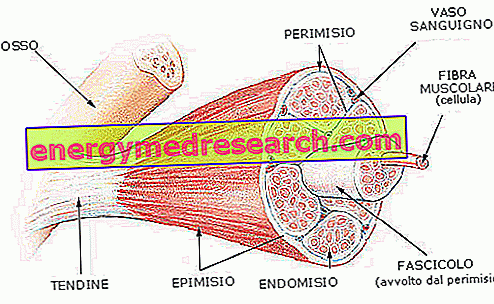Generality
The rupture of the capillaries of the eye is a phenomenon characterized by the shedding of blood from the small vessels that supply the organ of the visual apparatus .

This condition is quite common and can be caused by numerous factors, including ocular trauma, infections, hormonal changes, taking anticoagulant drugs, high blood pressure and various other systemic diseases. The causes can be identified by the ophthalmologist, starting from the location of the rupture of the capillaries of the eye ( just below the conjunctiva, in the vitreous body and / or in the retina ).
Furthermore, depending on the site of the broken capillaries, this condition involves different symptoms . Blood flow usually occurs in the form of a red patch, more or less visible, at the level of the surface or inside the eye.
In most cases, treatment is not necessary: the rupture of the capillaries of the eye resolves spontaneously within 1-3 weeks. Sometimes, however, the disorder can become frequent and / or extend beyond this period, signaling a more serious underlying condition (eg diabetes, vascular pathologies, coagulation disorders, etc.). If the problem persists beyond 14 days, it is essential to consult the doctor to understand the causes and resort to the most appropriate intervention for the case.
What's this
The rupture of the eye's capillaries is a condition that causes bleeding due to the lesion of the small vessels that supply the various eye structures; the blood effusion from large caliber vessels, on the other hand, is rare.
The rupture of the eye capillaries can occur at the level of:
- Space between the conjunctiva and the sclera (white part of the eye);
- Vitreous body ;
- Retina .
Subconjunctival haemorrhage is certainly the most frequent and least serious cause of this manifestation, while retinal and vitreous involvement is quite rare.
Depending on the location of the eye capillaries, a red spot appears, associated with a more or less limiting visual disturbance .
Types of eye capillary rupture
Depending on where the eye capillaries break, it is possible to distinguish 3 different types of blood transfer:
- Subconjunctival hemorrhage (or hyposphagma): this is the most common type of capillary rupture of the eye. The process involves the space located just below the conjunctiva (transparent surface of the eye). In fact, in the subconjunctival hemorrhage, a blood spill occurs due to the rupture of the small superficial capillaries, located between the sclera and the conjunctiva. This form of bleeding does not usually involve changes in the eye or sight.
- Vitreous hemorrhage : the rupture of the capillaries of the eye affects the vitreous body (between the posterior part of the crystalline lens and the retina), which is physiologically transparent . The collection of blood in the vitreous cavity prevents light from reaching the retina with a significant visual reduction .
- Retinal hemorrhage : the rupture of the capillaries of the eye involves the vascularized portion of the retina . Retinal haemorrhages can be a consequence of a trauma or sign of a systemic vascular disease (diabetes, venous occlusion etc.); due to these pathologies, the chorio-capillary system and the retinal vessels are damaged, with the release of blood that forms stains in the deep layers of the retina. These lesions are associated with severe eye changes.
Causes
The rupture of the capillaries of the eye is associated with the lesion of one or more blood vessels, which transfer their blood content to the bulbar conjunctiva, vitreous body or retina.
The causes of eye capillary breakage can be of various kinds.
Subconjunctival blood shedding is often caused by minor and non-worrying reasons, such as in the case of a cough or an effort that has led to an excessive increase in pressure.
On the contrary, capillary ruptures at the vitreous and retinal body should always be evaluated by the doctor, as they could indicate the presence of underlying pathologies that must be treated (eg arterial hypertension, macular degeneration, side effects of drugs, diabetes etc.).
Subconjunctival hemorrhage
Subconjunctival hemorrhage occurs when a small blood vessel breaks and bleeds at the bulbar conjunctiva. The conjunctival epithelium, in fact, contains numerous capillaries (in general, these small blood vessels are visible when the eye is inflamed), which are quite fragile and their walls can easily break.
The possible causes of capillary rupture of the eye at the subconjunctival level are:
- Excessive physical efforts (eg heavy lifting, but can also occur due to vomiting, violent sneezing or coughing);
- Strong increase in blood pressure (as in hypertension);
- Sudden change in pressure at the time of delivery (shaken baby syndrome);
- Small traumas (vigorous rubbing of the eye, penetration of a foreign body, incorrect use of contact lenses, etc.);
- Taking anticoagulants and supplements (such as aspirin, warfarin and ginseng);
- Hormonal changes in pregnancy;
- Post-operative minor complication in refractive surgery (example: LASIK for the correction of myopia, hypermetropia and astigmatism).
Occasionally, the loss of blood in the eye can also be a sign of other types of eye diseases (eg glaucoma, conjunctivitis, uveitis or serious infections).
Sometimes the rupture of the capillaries of the eye can be determined by more serious conditions : increased intracranial or intraocular pressure, blunt trauma, cranial fracture or coagulation disorder.
Vitreous hemorrhage
The rupture of the eye capillaries at the vitreous level can occur in cases of:
- Retinal detachment;
- Macular degeneration;
- Diabetes and diabetic retinopathy;
- Pathologies of the circulatory and vascular system;
- Glaucoma;
- Uveitis.
Retinal hemorrhage
The possible causes of retinal capillary rupture are:
- Systemic vascular disorders (arterial hypertension, venous occlusion, diabetes complications, etc.);
- Retinal detachment;
- Macular degeneration;
- Trauma (contusion or fracture of the skull).
Risk factors
Several factors can increase the fragility of the capillaries of the eye. For example, this phenomenon may represent a side effect of anticoagulant drugs, such as aspirin (acetylsalicylic acid) and warfarin. Although rare, St. John's wort, ginkgo biloba, ginger and cayenne pepper can increase the risk if taken in high doses.
Symptoms and Complications
The rupture of the eye's capillaries generally occurs with the appearance of a blood stain and general eye redness . This phenomenon can involve any person and can affect both the right and left sides.
The various causes that cause the capillary rupture of the eye trace a slightly different symptomatological picture for each phenomenon.
Subconjunctival hemorrhage
The rupture of the capillaries of the eye at the level of the sclera (white part of the eye) does not generally cause sight problems or significant discomfort, despite its visible appearance and the onset of slightly annoying symptoms .
Usually, the phenomenon appears as a hematic patch under the transparent conjunctival surface. The blood initially appears bright red; later, the spill may spread and the speck tends to become green or yellow, similar to a bruise.
In this case, the most common symptoms of eye capillary rupture include:
- Bleeding in the white part of the eye (blood in the eye);
- Headache (in some cases, but not always);
- Sensation of discomfort inside the eye (as if there were sand or a foreign body).
Eye pain is generally non-existent or minimal and there is no change in vision. Often, the shedding of blood due to the breaking of the capillaries of the eye is reabsorbed after about a week.
Vitreous or retinal hemorrhage
The rupture of the capillaries of the eye associated with vitreous or retinal hemorrhage produces practically the same symptoms. It should be remembered that these two conditions are rather rare compared to the first, but they can signal the presence of more serious problems and disorders.
The typical symptoms of capillary rupture at the vitreous or retinal level are the following:
- Eye pain ;
- Blurred view ;
- Blood stain in the eye ;
- If bleeding is limited: floaters ( loose bodies or "flying flies");
- In the most serious cases: impaired vision of varying degrees.
Diagnosis
- A normal eye examination may be sufficient to diagnose the common subconjunctival hemorrhage and establish the cause of the capillary rupture of the eye. If the cause of the capillary rupture is not clear, the ophthalmologist may decide to investigate the clinical picture with further investigations, to identify any pathologies affecting the eye. Sometimes, blood pressure measurement and complete blood counts are recommended to rule out the presence of bleeding disorders.
- Regarding the rupture of the capillaries of the vitreous body and of the retina it is good to face an eye examination for the evaluation of the bulb and the fundus of the eye, with particular attention to the retinal periphery.
- When the breakage of the capillaries of the eye has been caused by a trauma, it is necessary to carry out a thorough examination to understand the extent of the damage and the possible involvement of other structures.
- If the rupture of the capillaries of the eye is associated with ecchymosis or bleeding in other parts of the body, the patient undergoes diagnostic tests aimed at excluding systemic vascular diseases or bleeding defects.
Treatment
In the absence of infection or significant trauma, capillary rupture at the sub-conjunctival level is a condition that does not require any specific treatment. Generally, blood loss is self-limiting and resolves in two or three weeks, with no long-term complications .
If the patient feels discomfort or pain, the doctor may indicate the use of analgesic drugs . Even artificial tears can help reduce irritation.
Patients on aspirin or anticoagulants should consult their doctor to determine if it is safe to continue taking these medications during the healing process. If subconjunctival bleeding is due to trauma, additional medical measures may be necessary to promote recovery.
If an infection is present, eye drops or antibiotic ointments may be prescribed.
As for the breakage of the eye capillaries at vitreous or retinal level, however, it is essential to contact the trusted ophthalmologist to have a clear understanding of the intervention plan based on the individual case and the extent of the problem. Usually, anti-haemorrhagic drugs or laser surgery for damaged blood vessels are used.
Natural remedies
To promote the healing of the breakage of the capillaries of the eye and favor the reabsorption of hemorrhage, it is possible to intervene on one's eating habits, for example by consuming foods that contain flavonoids, present in berries, citrus fruits and red vine.
During recovery, it is best to avoid taking substances that could lead to dilation of capillaries, such as spicy and very hot foods, alcohol, coffee and carbonated drinks.
Prevention
Sometimes the breakage of the eye capillaries can be prevented. To avoid eye injuries, first of all it is useful to wear protective glasses whenever exposure to environments where volatile particles (such as dust) and intense sunlight are expected.
If recurrent ruptures of the capillaries of the eye occur, it is advisable to consult the doctor to ascertain or exclude the presence of a coagulation disorder or another underlying pathology that may favor the phenomenon.



